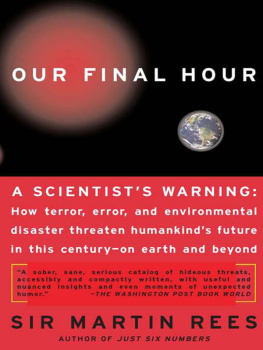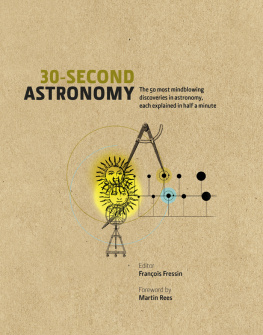Rees - Our Cosmic Habitat
Here you can read online Rees - Our Cosmic Habitat full text of the book (entire story) in english for free. Download pdf and epub, get meaning, cover and reviews about this ebook. City: Princeton;Oxford, year: 2001;2017, publisher: Princeton University Press, genre: Religion. Description of the work, (preface) as well as reviews are available. Best literature library LitArk.com created for fans of good reading and offers a wide selection of genres:
Romance novel
Science fiction
Adventure
Detective
Science
History
Home and family
Prose
Art
Politics
Computer
Non-fiction
Religion
Business
Children
Humor
Choose a favorite category and find really read worthwhile books. Enjoy immersion in the world of imagination, feel the emotions of the characters or learn something new for yourself, make an fascinating discovery.

Our Cosmic Habitat: summary, description and annotation
We offer to read an annotation, description, summary or preface (depends on what the author of the book "Our Cosmic Habitat" wrote himself). If you haven't found the necessary information about the book — write in the comments, we will try to find it.
Our Cosmic Habitat — read online for free the complete book (whole text) full work
Below is the text of the book, divided by pages. System saving the place of the last page read, allows you to conveniently read the book "Our Cosmic Habitat" online for free, without having to search again every time where you left off. Put a bookmark, and you can go to the page where you finished reading at any time.
Font size:
Interval:
Bookmark:
OUR COSMIC HABITAT
MARTIN REES


Copyright 2001 by Princeton University Press
Preface to the Princeton Science Library Edition
2017 by Princeton University Press
Published by Princeton University Press, 41 William
Street, Princeton, New Jersey 08540
In the United Kingdom: Princeton University Press,
6 Oxford Street, Woodstock, Oxfordshire OX20 1TR
All Rights Reserved
New Princeton Science Library Edition, 2017
Paper ISBN: 978-0-691-17809-7
The Library of Congress has cataloged the last edition of this book as follows:
Rees, Martin J.
Our cosmic habitat / Martin Rees.
p. cm.
Includes bibliographical references and index.
ISBN 0-691-08926-4 (cloth : alk. paper)
1. Cosmology. I. Title.
QB981 .R369 2001
523.1dc21 | 2001027835 |
British Library Cataloging-in-Publication Data is available
This book has been composed in Minion
Printed on acid-free paper.
www.press.princeton.edu
Printed in the United States of America
10 9 8 7 6 5 4 3 2 1

I PERCEIVED that I was on a little round grain of rock and metal, filmed with water and with air, whirling in sunlight and darkness. And on the skin of that little grain, all the swarms of men, generation by generation, had lived in labour and blindness, with intermittent joy and intermittent lucidity of spirit. And all their history, with its folk-wanderings, its empires, its philosophies, its proud sciences, its social revolutions, its increasing hunger for community, was but a flicker in one day of the lives of the stars.
OLAF STAPLEDON
Star Maker (1937)
 CONTENTS
CONTENTSPREFACE TO THE PRINCETON
SCIENCELIBRARY EDITION
 PREFACE TO THE PRINCETON
PREFACE TO THE PRINCETONSCIENCE LIBRARY EDITION
The night sky is the most universally-shared feature of our environment. Throughout history, humans have gazed up at the vault of heaven, interpreting it in their own way, and absorbing it in their culture. Astronomy is the grandest environmental science.
It was a major leap when nineteenth century astronomers realized that the stars were other Sunsmade of atoms like those on Earth, and governed by the same laws. Throughout the 20th century, ever more powerful instruments revealed a cosmos far vasterand displaying greater richness and varietythan our forebears envisaged. We learnt that we are literally the ashes of long dead starsthat the atoms in our terrestrial habitat were all forged in stars that lived and died before Earth formed. And our cosmic horizons hugely expanded in space and time. The Milky Way, our home galaxy, is just one of billions visible with powerful telescopes; and weve realized that this entire cosmic panorama emerged from a hot dense beginninga big bang about 13.8 billion years ago.
This understanding deepens our sense of wonder. And it emboldens us to pose even more ambitious questions. This book addresses whats surely the grandest of all cosmic conjectures: the idea that the universe astronomers can observeextending out to tens of billions of light-yearsis just a tiny part of physical reality. Could the aftermath of the big bang spread far beyond our observational horizon maybe even so far that all combinatorial options recur, and we have remote avatars? And thats not all. Could our big bang be just one of manyeven part of an infinite archipelago of diverse space-times? The plankton in a spoonful of water have no conception of the diversity of our Earth and its oceans. Astronomers current conception of physical reality may be equally constricted. The physical laws governing us and the stars may, in this grander perspective, be mere local bylaws, the overarching physical principles being on a deeper level and their consequences far more diverse than our imaginings.
In the years since this book was written, the multiverse concept has attracted growing attention from mainstream physicists. Its a scientific conceptnot just metaphysics. But it remains speculative, because we still await a compelling (and testable) theory that describes the ultra-dense early phases of the big bang. Indeed, I think we should be open minded about the possibility that the overarching theory is too complex for human minds to grasp and so will forever elude usawaiting some post-human intellects (organic or electronic) more powerful than our own.
The last decade has seen further progress in mapping our observable universe and understanding how atoms, stars and galaxies form and evolve. This is owed to further improvement in telescopeson the ground and in spaceand to advances in computing power. The most astonishing technical achievement described in this book, in my view, was the all-sky mapping of the faint microwaves pervading all space, the afterglow of creation, with a precision of one part in a million. This was the work of a Princeton-led group, using the WMAP spacecraft, propelled far beyond the Moon. Follow-up work by the larger European Planck spacecraft achieved even greater precision, and finer angular resolution. The patterns and ripples in this radiation, spread across the sky, very probably originated when our entire universe was of microscopic size. Its been even more of a triumph to show how the initially tiny density contrasts between regions of varying densities grows during cosmic expansion, and eventually leads to the emergence of galaxies and clustersa marvelous confluence between the physics of the very small and the very large.
Astronomers clearly cant do experiments on their objects of study. They are mere passive observers; moreover, most cosmic timescales are so long that no changes are discernable in a human lifetime. But they have two compensating advantages. They can actually observe how galactic populations evolve by looking at objects so far away that their light set out billions of years ago; and they can do experiments in the virtual world of their computers, simulating, far faster than in real time, how galaxies grow, crash together, and agglomerate into clusters.
Crucial to cosmic structure formation is the dark matter, which behaves like a swarm of particles that feel gravity, but neither emit nor absorb light. When I wrote the book, I genuinely expected that by today we would know what the dark matter particles actually are. But despite ingenious experimental efforts, their nature remains elusive, and awaits even more sensitive experiments and observations now being planned.
The so-called dark energy latent in empty space is less important for cosmic structures, but poses an even more fundamental challenge to physicists. Most theorists suspect that it is linked to the microstructure of space, about which we are still almost entirely ignorant. Were familiar with the idea that no material can be chopped up indefinitely: all substances have structure on the atomic scale. And there are good reasons to expect that space and time likewise manifest granularitybut this is on scales a trillion trillion times smaller than an atom, and wont be understood until there is a theory that links the quantum principle with Einsteins theory of gravity. I wont hold my breath for that breakthrough.
Next pageFont size:
Interval:
Bookmark:
Similar books «Our Cosmic Habitat»
Look at similar books to Our Cosmic Habitat. We have selected literature similar in name and meaning in the hope of providing readers with more options to find new, interesting, not yet read works.
Discussion, reviews of the book Our Cosmic Habitat and just readers' own opinions. Leave your comments, write what you think about the work, its meaning or the main characters. Specify what exactly you liked and what you didn't like, and why you think so.















